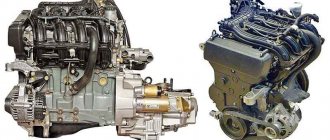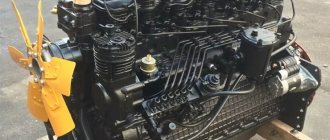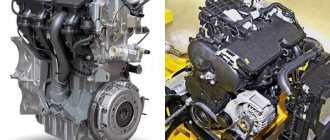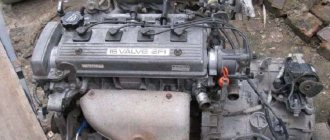In 1997, the engine plant in Ulyanovsk began assembling high-power engines. The first sample was the carburetor UMZ 4215, and a year later engineers created the 4216 engine, equipped with fuel injection and subject to the Euro 2 standard. Serial production began in 2003, and in 2012 the basic modification 42164 and varieties that meet Euro 4 requirements entered the market.
Engine 4216 mounted on a commercial GAZelle:
Engine device
UMZ-4216 is a gasoline injection engine with electronically controlled ignition and injection. Number of cylinders – 4, engine displacement 4216–2.89 liters. The unit in the basic version is capable of producing power up to 107 horsepower.
The basis for the development was the ZMZ-21 engine. The new UMP model has a similar design:
- engine valve location – top;
- the cylinder block is made of lightweight aluminum;
- Timing drive – gear;
- lower camshaft layout;
- 2 valves per engine cylinder.
The oil sump, stamped from steel, is also structurally similar.
Crankcase of Gazelle Business 4216 engines and related modifications:
As in all UMZ engines with 100 mm cylinders. in diameter, the sleeves are pressed into the BC and cannot be pressed out during repairs. If the cylinders wear out, the entire block will have to be replaced.
Main elements of the 4216 engine:
- aluminum BC, into which the above-mentioned cast iron sleeves are pressed;
- BC:
- Cylinder head, also aluminum;
- flywheel with ring gear;
- crankshaft with connecting rod (4 pieces) and main journals (5 bearings);
- pistons equipped with a single oil scraper and two compression rings;
- oil pump
- engine connecting rods;
- pushers and rods;
- engine bearings, connecting rods and main bearings;
- crankshaft pulley, hub;
- engine gaskets and seals;
- textolite camshaft gear and metal crankshaft gear.
Engine removed:
The crankshaft drives the timing belt through gears. Rods and pushrods transmit the movement coming from the camshaft to rocker arms, which operate the intake and exhaust valves.
Engine control is electronic. The engine operation is controlled by the MIKAS electronic unit, which receives signals from the TPS, shaft position sensor, knock and pressure sensors.
Sensor diagram from the official manual:
Technical characteristics of UMZ 4216
As already mentioned, the UMZ 4216 engine is a four-cylinder injection gasoline unit with 8 valves. The manufacturer declares 92 gasoline as the main fuel, but the use of gasoline with an octane number of 95 (as an additional one) is also permitted.
Technical characteristics of the UMZ 4216 engine:
| Name of motor characteristics | Meaning |
| Unit volume (working) | 2.89 liters. |
| Maximum engine power | 107 forces (can be up to 123, depending on the model) |
| Torque (max) | 235 N*m at 2200-2500 rpm. |
| Cylinders per engine | 4 |
| The order of activation of the cylinders in the working cycle | 1-2-4-3 |
| Fuel | Gasoline, unleaded Regular-92 (basic, optional 95, Premium and Euro) |
| Consumption per hundred | Nominally 11 liters in city mode, about 10 on the highway (actual numbers may vary) |
| Supplying the mixture to the cylinders | Injector |
| Feed control | Electronic |
| Engine cooling system | Closed type, liquid, refrigerant circulation - forced |
| Weight including clutch and electrical equipment | 172 kilograms |
Gasoline consumption declared by the manufacturer is not an absolute value and can increase significantly depending on the season of operation of the vehicle, load, and driving style. For example, the average fuel consumption of the GAZelle Business engine UMZ 4216 in reality shows about 13-15 liters in the city.
Price of a new and contract engine
How much the UMZ 4216 motor will cost depends on the modification, the availability of attachments and hydraulic compensators:
- UMZ 4216, 107 l. p., Euro-3 is found in configurations for “Gazelles” and “Sables” with an old and new frame for power steering, for 92 and 95 gasoline;
- UMZ 4216-41, 107 l. pp., Euro-3, adapted for GAZelle Business and Soboli Business, runs on 92 gasoline;
- UMZ 42164-80, 107 l. p., Euro-4 was released in configurations with a compressor, a frame for power steering and Delphi components for GAZelle Business and Soboley Business;
- UMZ 42164-70, 107 l. p., Euro-4, comes with or without a compressor for “GAZelle Business” and “Sable Business”;
- UMZ 421647, 100 hp, Euro-4, presented for cars with LPG.
The new UMZ motor is sold at prices ranging from 130 to 170,000 rubles.
Despite the low cost of a new engine, carriers prefer to buy used units. On average, the price for a contract UMP 4216 is 50 - 65,000 rubles.
Typical faults
The UMZ plant claims a service life of engines of the 4216 line of 250 thousand before the need for overhaul. In practice, faults appear earlier.
The main problems that owners of commercial vehicles with a UMP engine from the series under consideration have to face:
- high oil consumption due to waste through the piston rings;
- oil leaks;
- knocking of engine valves;
- failure of electronic sensors;
- engine overheating for various reasons.
Premature failures usually result from:
- violations of operating rules - the driver excessively “turns” the engine and overloads it, or exceeds the maximum permissible load of the machine;
- driving in difficult track conditions;
- incorrect, unqualified or untimely maintenance;
- use of poor fuel, lubricant or coolant.
Defects in the 4216 series are relatively rare, so the malfunction is most often associated with an actual breakdown, and not a factory defect, although such cases do exist.
Other possible problems:
- The engine leaks oil and liquid appears on the parts.
A possible cause is wear of the crankshaft rear oil seal. The problem often appears when driving for a long time at rpms above 2500; the 4216 is not designed to operate at very high rpms. Replacing the seals completely eliminates the problem.
- Engine vibrations, the engine “jerks” at idle or while driving.
The problem arises due to the uneven flow of the combustible mixture into the cylinders. Its causes may be malfunctions in the ignition system (plugs, coils, etc.) or injection (for example, a clogged injector). The car consumes a lot of fuel, the Check light may come on on the dashboard, and a misfire error is recorded in the ECU. In this case, a comprehensive diagnosis is required.
- The engine is knocking.
The most common cause is misaligned valves. To solve the problem, adjustments must be made. This procedure is standard and should normally be carried out every 15 thousand mileage. In addition to valves, the problem can be partially solved by installing hydraulic compensators.
If the valves are in order, you should check the condition of the connecting rod bearings and camshaft.
- Engine vibration.
Usually the engine begins to vibrate due to problems with ignition or physical wear of the cushions. It is also possible that the crank mechanism may become unbalanced.
- Engine overheating.
Problems with ignition and fuel supply systems
These problems are considered typical for engines with the 4216 series injector.
- The car does not enter self-diagnosis mode.
The reason is failures in the ECU or diagnostic ones.
- After ignition activation, Check does not go out.
Possible reasons are failure of the computer, control circuits or the control system as a whole.
- The fuel pump does not start after turning the ignition key.
The probable cause is pump failure, problems with the computer, power circuits or pump relay.
- The starter does not turn over the engine.
It is possible that the battery is discharged, the throttle or the starter itself is faulty, or there is a breakdown in the control/supply circuits of the starter.
- The engine does not start the first time, the speed fluctuates, the engine stalls, and black smoke comes out of the exhaust.
The reason is a malfunction of the synchronization sensor or an increase in the gap between the synchronization sensor and the teeth of the crankshaft synchronization disk.
- The engine does not start “hot”; the temperature sensor shows the coolant temperature above 70 degrees.
Possible malfunctions - there is no fuel pressure in the line, the pressure is too low or, conversely, high, the IAC, crankshaft sensor, control unit has failed, or the coil control circuits have been mixed up during installation.
It is necessary to carefully check all these nodes. Thus, fuel pressure may drop due to the trivial reason of an empty tank or an air lock in the line. Low pressure occurs when the fuel channels and filter are clogged, suction appears in the intake tract, a faulty gasoline pressure regulator or leaky gasoline lines. Too high pressure may occur due to a broken pressure regulator, a clogged drain line, or a broken fuel pump.
- The crankshaft rotates too quickly when idling.
Reasons: the throttle valve does not close completely, the coolant temperature sensor is miscalibrated, the IAC channel does not close.
- Malfunctions of the cylinder, or complete failure of it.
Reasons: malfunction of the armor wire or tip, violation of the spark plug gap, carbon deposits on it, or complete breakdown of the spark plug, problems with power supply/control of the injector, clogging or breakdown of the latter. Occasionally, a malfunction occurs due to ECU failures.
- Two cylinders fail/stop working at once.
Possible reasons: malfunction of the ignition coils (or their power supply and control systems), computer failure.
- Unstable operation at idle.
Possible malfunctions leading to this: suction at the inlet, in the engine crankcase ventilation or brake system, water getting into the tank, rattling of the TPS contacts.
- Sudden drops in engine speed during acceleration.
The error occurs due to problems with ignition or chattering of the TPS contacts.
- The engine cannot reach maximum power.
Reasons: the throttle valve does not open completely, the fuel filter is clogged, the TPS is miscalibrated, the air filter is dirty, the absolute pressure sensor is broken, or the high-voltage circuits of the engine are faulty.
- Abnormally high fuel consumption, CO emissions.
Problems leading to this: failure of the absolute pressure sensor, depressurization of injectors, air leaks, too high pressure in the fuel line (see above).
- Abnormally high CH emissions from the engine.
As a rule, this occurs due to faulty high-voltage circuits.
- Engine detonation.
Possibly, low-quality gasoline was poured in (with an incorrect ratio of fractions, low octane number, or diluted with water). The problem may also lie in broken shielding of the knock sensor cables, sensor calibration, or ECU failure.
Disadvantages of breakdowns and problems of the UMZ 4216 engine
The main problems of the 4216 engine are related to design flaws and problems in the control system:
- High fuel consumption occurs when the air filter and injectors are dirty. If there is an idle air regulator, check its operation and change the pipes. Carry out ECU diagnostics;
- knocking in the engine appears due to increased clearance between the rocker arm and the valve. The noise also indicates wear of the connecting rod bearing, scuffing on the piston skirt, wear of the connecting rod head and pusher;
- if oil consumption exceeds 150 g per 100 km, install a new filter, change the oil, oil seals, oil seals and seals. Grease may leak through the tappet cover gaskets;
- Damage to the radiator pipe leads to engine overheating, deformation of the aluminum cylinder head and burnout of the gasket;
- in reduction starters, plastic gears that are difficult to find often fail;
- a malfunction of the control unit or sensors leads to failure of the electric fuel pump, incomplete opening of the throttle valve, interruptions in cylinder operation and detonation at full power;
- Low-quality standard wiring often melts in the area where the lambda probe is located. Engine vibrations lead to wire chafing and short circuits.
Similar article Which engine is suitable for the VAZ 2106
The UMZ 4216 engines produced in 2008 had a 70 A generator and a 55 Ah battery, which turned out to be insufficient for GAZelles. In winter, it was not always possible to start the car, since the battery only had enough power for a few revolutions of the shaft. Subsequent models were equipped with 90 A generators and 66 Ah batteries.
Before overhaul, according to the plant, the 4216 engine runs 250 - 300 thousand kilometers. In order for the motor to serve its intended life, it is necessary to follow the maintenance regulations and operating rules.
Owner reviews
Those who drive personal and business cars with a UMZ 4216 engine generally praise these engines. The main advantages, according to car enthusiasts:
- affordability of both the engine itself and parts for repair;
- high maintainability due to the simplicity of the device;
- quite moderate, for its characteristics, fuel consumption;
- good torque of the engine.
Many experienced car owners even do their own repairs; in general, service operations are quite simple and can be carried out almost in the field. Only the injector can cause complexity - its design, repair and adjustment are fundamentally more complicated when compared with carburetor analogues, and require special knowledge and equipment.
But there are also negative reviews. Main complaints:
- engine tendency to overheat;
- breakdown of sensors with subsequent “triple”, loss of traction and other problems;
- high oil consumption - fluid leaks, according to drivers, “from all the cracks.”
Most of the complaints are related to the fact that the driver came across a copy of the engine with a defect, which, although not so often, does happen. Typical factory defects of the 4216 series engine:
- air leakage occurs due to a cracked intake manifold;
- Oil pressure drops due to a defective pump;
- failure of the electromagnetic cooling clutch and further overheating.
There are often cases when owners, faced with problems, modify the engine themselves. For example, to combat overheating, a three-row copper radiator is installed, which replaces the standard cooling element: copper copes with its tasks better. Another popular method is to equip the engine with an electric fan, the control switch of which is brought into the cabin. If the coolant sensor shows a critical temperature, the person driving activates additional forced cooling.
Motorists note that a complete engine overhaul eliminates the bulk of “generic diseases”, provided that the work is carried out competently and using high-quality original parts.
Engine reviews
Drivers note the main advantage of the UMZ 4216 Euro-4 engine in its ability to maintain high torque at low speeds. This gives the engine the traction characteristics that are necessary for trucks and minibuses: good throttle response, hill climbing, and load capacity.
The disadvantages of the engine include low speed - 85 - 90 km/h, high fuel consumption, possible oil leaks and poor-quality wiring.
Cargo transportation companies choose vehicles with UMZ 4216 engines because of the low price and good reputation of the plant. Ulyanovsk residents know how to make units for military all-terrain vehicles, which means they have a good idea of the design requirements of commercial vehicles. For example, timing gear drive is the most reliable solution than a belt with tensioners and dampers.
Alternatives
If the driver “came across” a car with a defective engine, which he has no desire to constantly repair, he can try to replace it with another one suitable for the car. There are different options for swapping an engine, but mostly those who decide to swap choose the ZMZ-405 engine. This choice is due to several reasons:
- unpretentiousness of the engine to fuel quality;
- reliability - the engine breaks down infrequently;
- it is affordable when compared with imported analogues;
- the car requires a minimum of modifications to work with this engine;
- There are many used 405, 406 engines on sale in good condition, at a price several times cheaper than a new one. And even a minor repair of a contract engine will be cheaper than buying a “fresh” unit.
The GAZelle-Business plant now regularly installs a Cummins turbodiesel power unit, but the option of replacing it with it is rarely considered due to the high cost and high sensitivity of the American engine to fuel quality, with which there are traditional problems in Russia.











